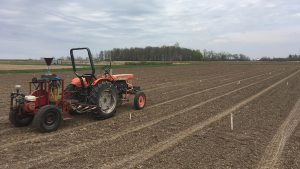Benchmarking for success
RECENT STUDY BY BDO

FARMERS ARE NOTORIOUS for comparing their operations, always looking to see how they measure up to their neighbours. Even without access to a coffee shop or parts counter to chat about the weather, yields, and market prices these days, farmers still want to know how their business measures up against everyone else. The good news is, for those farmers interested in comparing their farm operations to fellow Canadian farmers, BDO Canada recently released a new benchmarking study that can offer insights into how Ontario grain farmers stack up in the industry.
The 2020 financial benchmarking report, Farm profitability: Benchmarking for better decisions was developed by BDO in partnership with Agrifood Management Excellence Inc. to benchmark financial performance based on operational results.
“A benchmark is simply a performance comparison tool that can help farmers make better business decisions by highlighting strengths and weaknesses of a farm’s financial operational performance and how that compares to other Canadian farms,” says Coralee Foster, partner with BDO Canada and grain farmer in Mitchell, Ont.
The study used anonymous financial records from more than 1,000 BDO client farms over six years, from 2012 to 2018. “The benchmarks are a starting place for discussions about ways to improve and reinforce areas that are successful.”
The report covers key benchmarks for grain and oilseed operations in Ontario and Manitoba (in addition to dairy, beef feedlots, and chicken farms). It includes a standardized financial statement and five standard farm costs, ratios, and margins used as benchmarks, addresses using them in the diagnosis of management issues, and how to compare results and apply benchmarks.
Foster says she’s been sharing the study with clients and is finding farmers are getting lessons from their own farms’ five-year trend analysis, while comparing themselves to similar farm operations in the report.
“And that’s how a lot of strategic discussions have started,” she says, including her own farm, where she tested the benchmarking information with her husband and sons.
“I’m the numbers person, while they would rather be in the field or the shop. We sat down and reviewed our annual statements and the benchmarking data, just like I would with any of my clients.”
The result was positive, with insightful discussions that everyone contributed to.
DATA ANALYSIS
The benchmarking study was adapted from Dr. Larry Martin and Travis Jansen’s report, Benchmarks from Standardized Farm Financial Statements. As co-author of the report, Martin was eager to take a new approach to measuring success through benchmarking and standardizing how financial records are reviewed and evaluated.
“All farms operate differently, but what if we could break down the accounting side of the business to evaluate individual management decisions?,” says Martin. “And then take it one step further to compare those decisions and numbers to other farms to evaluate performance and identify opportunities.”
With so many uncontrollable variables in farming such as weather, market prices, and input and labour costs, the benchmarks and balance sheet ratios can help farmers focus on where they can take control of their operation through management decisions.
“A crop failure isn’t anyone’s fault, but using the suggested ratios in this study to evaluate a farm operation can help focus on problem areas that can be resolved and improve profitability,” says Martin.
The 2020 report focuses on balance sheet numbers for solvency and financial risk. Martin analyzed two new ratios — total debt over operating income and bank debt over operating income. Both measure solvency and financial risk — key elements to staying competitive.
MEASURING UP
“Profitability isn’t just about cost control and lower debt — it also comes from production and price management. In fact, the least profitable crop farms in Ontario actually have lower cost per acre but barely half the revenue,” says Foster, noting the study revealed differences between the most and least profitable grain and oilseed farms in Ontario are significant.
According to the report, the most profitable farms have a 12% advantage for costs of goods sold/revenue (cost of direct inputs) and a 35% advantage in total operating costs/revenue (costs to keep facilities, equipment and people running).
For example, a farm with $1,000,000 revenue in the most profitable group could have $450,000 left after paying all operating costs, while a similar farm in the least profitable group could have only $100,000. This is what is left to cover capital costs and take profits.
Foster notes the cost of land ownership and land rental have a huge impact on profitability. Many farmers know the revenue and input cost per acre, but don’t factor in the operating costs — machinery, labour, and other variable costs when considering if there is a financial benefit to securing more land.
“The cost of capital as a percentage of revenue has been an eye opener for many clients, not just on grain and oilseed farms. Leveraging debt is good, but only in moderation,” she says. “It’s not sustainable to have costs of capital too high year after year.”
The study also shows the importance of comparing the financial performance of individual enterprises, such as which crops made more money, not just yielded more. The trends around this information can provide insight to farmers to assist with management planning based on financial information.
CRUNCHING NUMBERS
The report revealed a few surprises to the team, and one of the biggest surprises from the grain and oilseed study was that size doesn’t matter. “Better performance isn’t just about scale or even cost management,” says Foster. “The ability to generate revenue is equally important.”
According to Martin, a few common problems emerged when it came to profitability on grain and oilseed farms, including over investing in machinery, poor grain marketing decisions (not selling at the best price possible), agronomics (underperforming yield, high fertilizer costs) and labour costs (too many people on the payroll).
“The report confirmed that there is always room for improvement when it comes to management decisions on the farm,” says Martin. “And using the ratios and benchmarks in the report can help any farmer identify where they need to focus.”
The full 2020 report can be downloaded from BDO’s website: bdo.ca.
HOW DOES YOUR FARM MEASURE UP?
With so many new and uncontrollable variables facing farm operations this year, farmers may want to take a second look at their finances.
“It will be interesting to see how the current global pandemic impacts balance sheets and financial ratios,” says Coralee Foster, partner with BDO Canada. “Pricing, access to processing facilities, sourcing of inputs, shortages of labour, and an economic recession are all factors that we expect will have an impact.”
BDO and Agri-Food Management Excellence Inc., the team that published the 2020 Farm profitability: Benchmarking for better decisions report, offer some tips for evaluating key financial ratios and benchmarking your own farm’s success.
- Do your own math — visit Agrifoodtraining.com to download two spreadsheets — a generic cash income statement and generic accrual income statement. Crunch the numbers to evaluate your own farm finances.
- Compare — read the benchmarking report, available at bdo.ca, and compare your ratios with the benchmark averages. If your ratios aren’t in line with where you want them to be, ask yourself why? Review the per acre information and compare your numbers, paying close attention to problem areas.
- Identify the problem — if the numbers are ‘off’, find out why. High labour costs, poor yield, low market prices, and spending too much on inputs are common culprits for undesirable financial ratios on grain and oilseed farms.
- Make a plan — it isn’t enough to find the problem; your next steps could make the difference between profit and loss. Set achievable objectives such as researching a new way to purchase inputs, aiming to do a better job at marketing your crop next year, or hiring an agronomist to help boost yields.
“Comparing your own farm’s financials with these benchmarks is powerful,” says Foster. “It lets a farmer ask themselves, if this is how the most profitable farmers look, how can we improve and do things better?” •


























